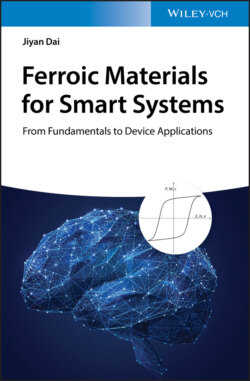Читать книгу Ferroic Materials for Smart Systems - Jiyan Dai - Страница 14
1.2.3 Ferroelectric RAM (FeRAM)
ОглавлениеFerroelectric RAM (FeRAM, F‐RAM, or FRAM) is a random‐access memory that is similar to Dynamic Random Access Memory (DRAM) in structure but uses a ferroelectric layer instead of a dielectric layer to achieve non‐volatility. FeRAM is one of a growing member of alternative non‐volatile random‐access memory technologies that offers the same functionality as flash memory.
Advantages of FeRAM over flash memory include lower power usage, faster write performance, and much greater maximum read/write endurance (about 1010–1014 cycles). FeRAMs have data retention of more than 10 years at +85 °C (up to many decades at lower temperatures). Market disadvantages of FeRAM are much lower storage densities than flash devices and higher cost.
A ferroelectric material has a nonlinear relationship between the applied electric field and the stored charge. Specifically, the ferroelectric characteristic has the form of a hysteresis loop, which is very similar in shape to the hysteresis loop of ferromagnetic materials. The dielectric constant of a ferroelectric is typically much higher than that of a linear dielectric because of the effects of electric dipoles formed in the crystal structure of the ferroelectric material. When an external electric field is applied across a dielectric, the dipoles tend to align themselves with the field direction. This alignment process is produced by small shifts in the positions of ions and shifts in the distributions of electric charges in the crystal structure. After the charges are removed, the dipoles retain their polarization state. Binary “0”s and “1”s are stored as one of the two possible electric polarizations in each data storage cell. For example, in Figure 1.10, a “1” is encoded using the negative remnant polarization “−Pr,” and a “0” is encoded using the positive remnant polarization “+Pr”. In this FET structure with a ferroelectric layer as gate dielectric, the two polarization states correspond to different Vth, resulting in a memory window within which the ON and OFF states of the FET can be read.
Figure 1.10 Schematic diagram of field‐effect transistor (FET) and the current–voltage (I–V) characteristics induced by two different polarization state.
FeRAM remains a relatively small part of the overall semiconductor market. In 2016, worldwide semiconductor sales were US $338.93 billion (according to WSTS, SIA), with the flash memory market accounting for US $59.2 billion (according to IC insights (Cho 2018)). The 2017 annual revenue growth of Cypress semiconductor, perhaps the major FeRAM vendor, were reported to be US $2.33 billion. The much larger sales of flash memory compared with the alternative FeRAMs support a much larger research and development effort. Flash memory is produced using semiconductor linewidths of 15 nm at Renesas Electronics Corporation (2017). Flash memory can store multiple bits per cell (currently Samsung has announced the 64‐layer 512‐Gb in the NAND flash devices). As a result of innovations in flash cell design, the number of bits per flash cell is projected to increase to double or even to triple. As a consequence, the areal bit densities of flash memory are much higher than those of FeRAM, and thus the cost per bit of flash memory is orders of magnitude lower than that of FeRAM.
